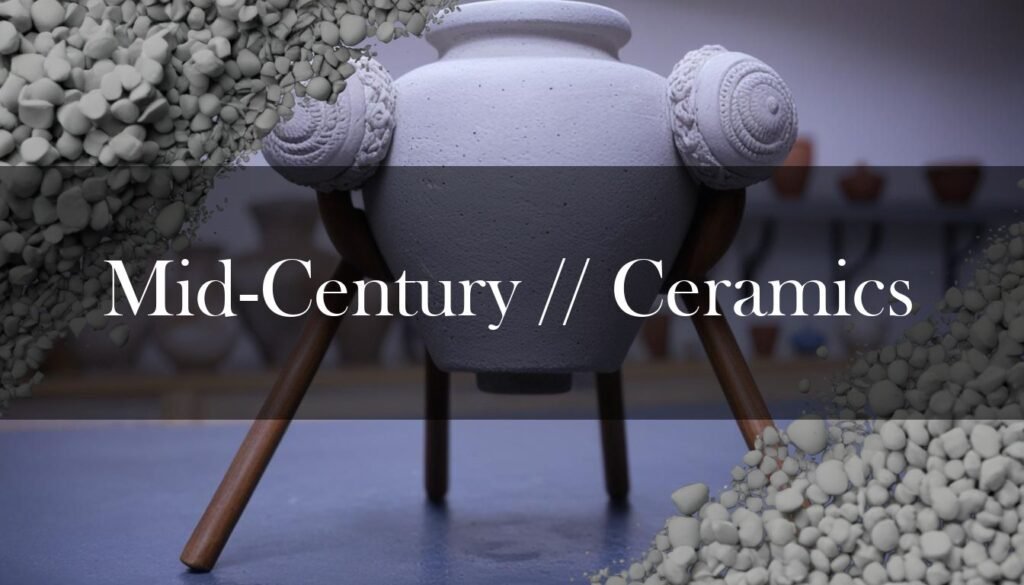Ah, mid-century modern ceramics – it just sings of clean lines, organic shapes, and a touch of retro cool! From the 1940s to the 1960s, this movement transformed design, ditching the fussy ornamentation of the past for simplicity and functionality. Imagine post-war optimism channeled into every curve and glaze! You can really see the influence of the Bauhaus movement and Scandinavian design, blending art, craft, and technology in pieces that are both gorgeous and useful. Russel Wright and Eva Zeisel, for example, designed dinnerware with a free-flowing style that really captured the smooth, flowing feel of the era.
What’s super interesting is how different regions put their own spin on the style. Over in California, the California Clay Movement was making waves, with Peter Voulkos leading the charge. He really shook things up at the Los Angeles County Art Institute, encouraging artists to push boundaries with radical forms and glazing techniques, blurring the line between functional pottery and abstract sculpture. Then you’ve got Italy, where Bitossi Ceramiche, under Aldo Londi, was creating pieces bursting with vibrant colors and bold patterns. His “Rimini Blu” series became an icon, reflecting that energetic “Dolce Vita” vibe with its unique glazes and handcrafted feel. And let’s not forget Scandinavia, where designers like Stig Lindberg and Wilhelm Kåge at Gustavsberg pottery were combining traditional craftsmanship with modernist ideas, creating whimsical yet disciplined forms. You can find similar inspiration from the Bauhaus pottery movement, where form and function were key.
Now, if you’re hoping to spot some authentic mid-century modern pottery, keep an eye out for specific pottery marks. McCoy Pottery often stamped their pieces “McCoy U.S.A.”, while Metlox Pottery proudly marked theirs “Metlox Pottery Made in California”. Hall China Company, famous for its Autumn Leaf line, simply used “Hall”. Heath Ceramics, still around today, stamps their pieces with “Heath” and “Made in USA”. Lane & Co. is typically marked with “Lane & Co.”, while LaSolana Pottery are often marked on the bottom of the piece. You might also stumble across Roseville Pottery, though some pieces are unmarked, and Lenox China, known for their fine porcelain and later Temperware, marked simply with “Lenox”.
Of course, several artists left their mark on this era. Toshiko Takaezu, for instance, blended Japanese traditions with modernist sensibilities, creating those gorgeous “closed-form” vessels, sometimes with clay fragments inside that rattle when you move them! And then there’s Peter Voulkos, who revolutionized ceramics with his large-scale abstract sculptures, helping to elevate the craft to fine art. Paul Soldner pioneered American-style raku firing, creating those unpredictable and unique surface effects. Stan Bitters is celebrated for his large-scale ceramic murals that meld with architectural spaces, while Janet Rothwoman created earthy, hand-built sculptures that felt both primordial and ahead of their time. The influence of Roger Capron can be seen in his innovative forms and decorative motifs, and Robert Maxwell was celebrated for his stylish designs that blended form and function. And Guido Gambone’s vibrant colors and abstract patterns helped to shape modernist ceramics. To learn more about the blending of art and expression, consider reading about studio pottery.
“Mid-century modern ceramics embody a unique blend of artistry and functionality, reflecting the optimism and innovation of the era.”
When you’re admiring a piece of mid-century modern ceramic, take note of those clean lines and organic shapes, often drawing inspiration from nature. The bold colors and innovative glazes are a real hallmark, and there’s a beautiful integration of form and function – these pieces were meant to be both beautiful and useful! Even with mass production, you’ll often find a handcrafted quality, with hand-painted details and unique textures. And keep an eye out for those cultural influences, like Asian art, raku firing, and symbolic stamps. All of this makes these ceramics so special, with the designs of Edith Heath’s “Coupe” line, Aldo Londi’s “Rimini Blu” collection, and Kaj Franck’s practical designs for Arabia still exemplifying that timeless appeal. As for value, that depends on the designer, manufacturer, rarity, condition, and current market demand. A rare “tube cat” by Aldo Londi can go for around £2,400! Remember to do your research and get hands-on when authenticating pieces, and happy collecting!





